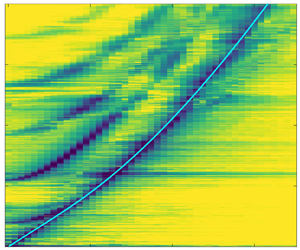Article contents
Surface waves along liquid cylinders. Part 2. Varicose, sinuous, sloshing and nonlinear waves
Published online by Cambridge University Press: 27 July 2021
Abstract

Gravity–capillary waves propagating along extended liquid cylinders in the inviscid limit are studied in the context of experiments on sessile cylinders deposited upon superhydrophobic substrates, with tunable geometries. In Part 1 of this work (Pham et al., J. Fluid Mech., vol. 891, 2020, A5), we characterised the non-dispersive regime of the varicose waves. In this second part, we characterise the varicose waves in the dispersive regime, as well as the sinuous and the sloshing modes. We numerically study the shape function of the system (the counterpart of the standard  $\tanh$ function of the dispersion relation of a gravity–capillary wave in a rectangular channel) and the cutoff frequencies of the sloshing modes, and show how they depend on the geometry of the substrate. A reduced-gravity effect is evidenced and the transition between a capillary- and a gravity-dominated regime is expressed in terms of an effective Bond number and an effective surface tension. Semiquantitative agreement is found between the theoretical computations and the experiments. As a consequence of these results, resorting to the inviscid section-averaged Saint-Venant equations, we propose a Korteweg–de Vries equation with adapted coefficients that governs the propagation of localised nonlinear waves. We relate these results to the propagation of depression solitons observed in our experimental set-up and along Leidenfrost cylinders levitating above a hot substrate (Perrard et al., Phys. Rev. E, vol. 92, 2015, 011002(R)). We extend our derivation of the Korteweg–de Vries equation to solitary-like waves propagating along Plateau borders in soap films, evidenced by Argentina et al. (J. Fluid. Mech., vol. 765, 2015, pp. 1–16).
$\tanh$ function of the dispersion relation of a gravity–capillary wave in a rectangular channel) and the cutoff frequencies of the sloshing modes, and show how they depend on the geometry of the substrate. A reduced-gravity effect is evidenced and the transition between a capillary- and a gravity-dominated regime is expressed in terms of an effective Bond number and an effective surface tension. Semiquantitative agreement is found between the theoretical computations and the experiments. As a consequence of these results, resorting to the inviscid section-averaged Saint-Venant equations, we propose a Korteweg–de Vries equation with adapted coefficients that governs the propagation of localised nonlinear waves. We relate these results to the propagation of depression solitons observed in our experimental set-up and along Leidenfrost cylinders levitating above a hot substrate (Perrard et al., Phys. Rev. E, vol. 92, 2015, 011002(R)). We extend our derivation of the Korteweg–de Vries equation to solitary-like waves propagating along Plateau borders in soap films, evidenced by Argentina et al. (J. Fluid. Mech., vol. 765, 2015, pp. 1–16).
JFM classification
- Type
- JFM Papers
- Information
- Copyright
- © The Author(s), 2021. Published by Cambridge University Press
References
REFERENCES
Le Doudic at al. Supplementary Movie
Generated by a micro-pipette at one tip of the drop, a liquid jet induces a strong deformation of the drop. Waves propagate ahead of a solitary depression wave and the latter travels at a speed lower than the propagation speed of the long-wavelength waves. This depression wave corresponds to a negative-amplitude Korteweg--de Vries soliton.
- 3
- Cited by



